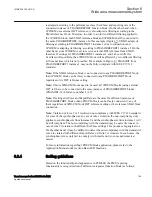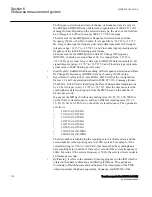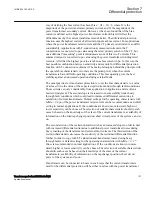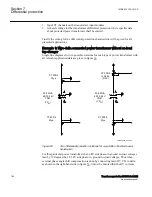
7.1.3.2
Elimination of zero sequence currents
M15266-286 v7
A differential protection may operate undesirably due to external ground-faults in cases
where the zero sequence current can flow on only one side of the power transformer,
but not on the other side. This is the case when zero sequence current cannot be
properly transformed to the other side of the power transformer. Power transformer
connection groups of the Wye/Delta or Delta/Wye type cannot transform zero sequence
current. If a delta winding of a power transformer is grounded via a grounding
transformer inside the zone protected by the differential protection there will be an
unwanted differential current in case of an external ground-fault. The same is true for
an grounded star winding. Even if both the wye and delta winding are earthed, the zero
sequence current is usually limited by the grounding transformer on the delta side of
the power transformer, which may result in differential current as well. To make the
overall differential protection insensitive to external gound-faults in these situations the
zero sequence currents must be eliminated from the power transformer IED currents on
the grounded windings, so that they do not appear as differential currents. This had
once been achieved by means of interposing auxiliary current transformers. The
elimination of zero sequence current is done numerically by setting
ZSCurrSubtrWx
=
Disabled
or
Enabled
and doesn't require any auxiliary transformers or
zero sequence traps. Instead it is necessary to eliminate the zero sequence current from
every individual winding by proper setting of setting parameters
ZSCurrSubtrWx
=
Disabled
or
Enabled
7.1.3.3
Inrush restraint methods
M15266-6 v7
With a combination of the second harmonic restraint and the waveform restraint
methods it is possible to get a protection with high security and stability against inrush
effects and at the same time maintain high performance in case of heavy internal faults
even if the current transformers are saturated. Both these restraint methods are used by
the IED. The second harmonic restraint function has a settable level. If the ratio of the
second harmonic to the fundamental in the differential current is above the settable
limit, the operation of the differential protection is restrained. It is recommended to set
parameter
I2/I1Ratio
=
15%
as default value in case no special reasons exist to choose
another value.
7.1.3.4
Overexcitation restraint method
M15266-320 v9
In case of an overexcited transformer, the winding currents contain odd harmonic
components because the currents waveform are symmetrical relative to the time axis.
As the third harmonic currents cannot flow into a delta winding, the fifth harmonic is
the lowest harmonic which can serve as a criterion for overexcitation. The differential
protection function is provided with a fifth harmonic restraint to prevent the protection
from operation during an overexcitation condition of a power transformer. If the ratio
of the fifth harmonic to the fundamental in the differential current is above a settable
Section 7
1MRK 504 163-UUS A
Differential protection
140
Transformer protection RET670 2.2 ANSI
Application manual
Summary of Contents for RELION RET670
Page 1: ...RELION 670 SERIES Transformer protection RET670 Version 2 2 ANSI Application manual ...
Page 2: ......
Page 48: ...42 ...
Page 64: ...58 ...
Page 74: ...68 ...
Page 104: ...98 ...
Page 194: ...188 ...
Page 518: ...512 ...
Page 618: ...612 ...
Page 648: ...642 ...
Page 666: ...660 ...
Page 672: ...666 ...
Page 682: ...676 ...
Page 844: ...838 ...
Page 868: ...862 ...
Page 956: ...950 ...
Page 964: ...958 ...
Page 1004: ...998 ...
Page 1014: ...1008 ...
Page 1015: ...1009 ...












































